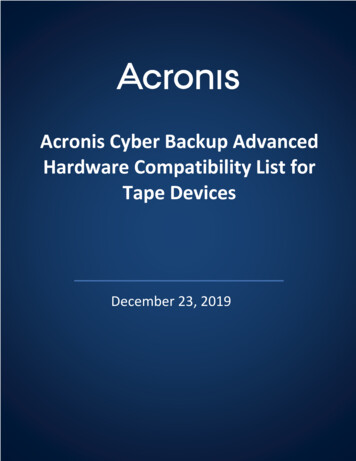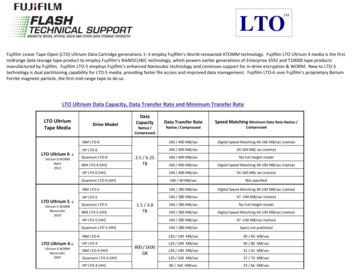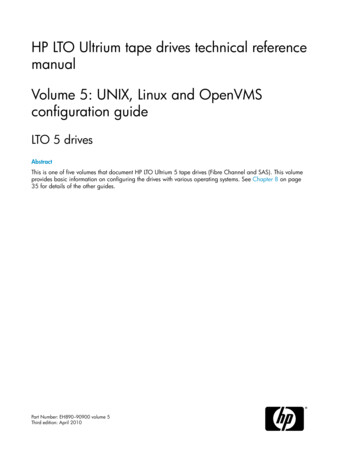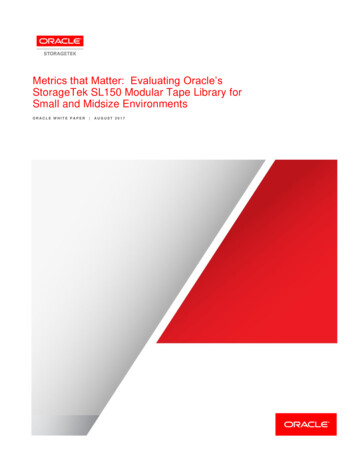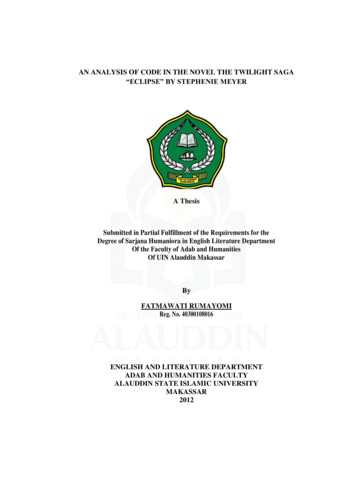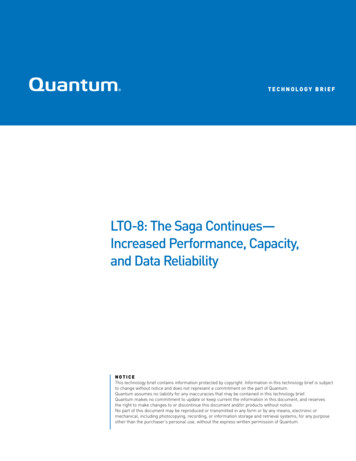
Transcription
TECHNOLOGY BRIEFLTO-8: The Saga Continues—Increased Performance, Capacity,and Data ReliabilityNOTICEThis technology brief contains information protected by copyright. Information in this technology brief is subjectto change without notice and does not represent a commitment on the part of Quantum.Quantum assumes no liability for any inaccuracies that may be contained in this technology brief.Quantum makes no commitment to update or keep current the information in this document, and reservesthe right to make changes to or discontinue this document and/or products without notice.No part of this document may be reproduced or transmitted in any form or by any means, electronic ormechanical, including photocopying, recording, or information storage and retrieval systems, for any purposeother than the purchaser’s personal use, without the express written permission of Quantum.
TABLE OF CONTENTSIntroduction . . . . . . . . . . . . . . . . . . . . . . . . . . . . . . . . . . . . . . . . . . . . . . . . . . . . . . . . . . . . . . . . . . . . . . . . . . 3Comparing LTO-7 and LTO-8 Specifications . . . . . . . . . . . . . . . . . . . . . . . . . . . . . . . . . . . . . . . . . . . . . . 3Technology Improvements and Changes that Provided the Results . . . . . . . . . . . . . . . . . . . . . . . . . . 3LTO-8 Full-Height vs. LTO-8 Half-Height Drive Formats . . . . . . . . . . . . . . . . . . . . . . . . . . . . . . . . . . . . 62LTO-8: The Saga Continues—Increased Performance, Capacity, and Data Reliability
TECHNOLOGY BRIEFINTRODUCTIONThis technology brief provides a detailed description of technology improvements for LTO-8 tape drives and media whichhave increased capacity, performance, and reliability. The LTO-8 drive is available in two versions: full-height (FH) andhalf-height (HH) drive form factors. Section 2 of this document compares each drive version to help customers understandwhich is best for their environment and use case.The LTO tape format has become the market-dominating standard for magnetic recording tape drives and media over thepast years. The technology has progressed from LTO-1 (2000) and most recently has delivered the latest generation withthe release of LTO-8 (2017).COMPARING LTO-7 AND LTO-8 SPECIFICATIONS Capacity: 100% increase Performance: 20% increase Tape drive durability improvements Media reliability improvements, which are particularly valuable with increasing demands for long-term retention:100x increase in data reliability due to improved bit error rate (BER) and advanced Barium Ferrite (BaFe) mediaFeatureLTO-5LTO-6LTO-7LTO-8M Format (FH)LTO-8(FH)Native capacity1.5 TB2.5 TB6 TB9 TB12 TBCompressed capacity3.0 TB6.25 TB15 TB22.5 TB30 TBNative performance140 MB/sec500 GB/hr160 MB/sec576 GB/hr300 MB/sec1.08 TB/hr300 MB/sec1.08 TB/hr360 MB/sec1.38 TB/hrCompressed performance280 MB/sec1 TB/hr400 MB/sec1.4 TB/hr750 MB/sec2.7 TB/hr750 MB/sec2.7 TB/hr900 MB/sec3.24 TB/hr1 in 10171 in 10171 in 10191 in 10191 in TO-7/LTO-M8Hard BERRead/write back toTECHNOLOGY IMPROVEMENTS AND CHANGES THAT PROVIDED THE RESULTSLTO-8 continues to deliver the capacity and performance improvements which were introduced with LTO-7. In the nextsection, which explains many of the technology improvements, all “LTO” references apply to both LTO-7 and LTO-8. Anydifferences between LTO-7 and LTO-8 are specifically identified.Capacity: LTO capacity increased with the final transition to using BaFe media. Some manufacturers started this transitionwith LTO-6 and adopted the new media formulation. This change is now complete for all LTO Consortium partners. TheBaFe media composition has smaller magnetic particles, which allow increased recording bit density, resulting in highercapacity. A new servo format was adopted to reduce signal noise, improve positional sensitivity, and implement a higherbandwidth servo—which were enablers for higher capacity, higher transfer rates, and improved data durability. Anotherkey differentiator for LTO is the Aggregated Rewrite format that achieves smaller-capacity overhead, therefore, higherefficiency tape areal utilization. This is accomplished by compressing all unwritten user data sections due to media errorsand rewriting them at the end of each data set, resulting in lower- capacity overhead: 3% with LTO versus 5% with LTO-6.LTO-8: The Saga Continues—Increased Performance, Capacity, and Data Reliability3
Performance: LTO tape drives have increased the data buffer to 1 GB from the 512-MB buffer used in prior generations.The increased buffer size helps the tape drive continue to write data in streaming mode—even when ingest data rates arenot consistent. Another major change for LTO that impacts performance is a new recording head design that uses 32-R/Wchannels, an increase from the 16-R/W channel head used in prior LTO formats. It is the combination of the new headdesign and the increased data density using the BaFe media that delivers the increased performance for LTO. In newergenerations of LTO, the media is moving at a slower rate (LTO-8 @ 4.731 m/sec, LTO-7 @ 5.01 m/sec vs. LTO-6 @ 6.83 m/sec) compared to prior generations while still increasing maximum data performance. Slower tape speed is an enabler forfuture generations of LTO drives to offer higher data rates while still using 32 data channels.Data integrity: LTO has a new error-correcting code (ECC) data format, which results in higher data durability comparedto LTO-6 when used with new and improved BaFe media and the new high-performance servo system. The LTO ECCformat is based on a two-dimensional interleaved dual error-correction code, where the inner code is operated in errordetection and correction mode, where the outer code is in erasure mode. LTO’s unique two-dimensional interleavingalgorithm randomizes media defects and burst errors. This randomization enables ECC to work efficiently, resultingin extremely low BER numbers. Starting with LTO-7, the channel number has been increased to 32 from 16, and theinner ECC has been modified to include header metadata along with the user data such that both are now protected bya stronger ECC format. The LTO-7 and LTO-8 format is (249,237,13) where LTO-6 format is (240,230,11). The LTO codeword is 9 bytes longer with two bytes more parity. This new architecture is the key to achieving even lower BER numberscompared to LTO-6. It is this change that made it possible for the BER detection specification for LTO to be increasedto no more than a single bit error for every 1 x 1019 of bits transferred. This data-integrity checking is 100x better thanLTO-6 and is considered to be enterprise-class data-integrity checking.The LTO BER specification is based on a calculation of uncorrectable C2 ECC events, assuming all errors are randomand uncorrelated. This is a theoretical analysis, since experimentation-based estimates will require approximately 130years at a 300-MB/sec data rate to encounter an error event. These theoretical calculations are based on an LTO-7with a 32-channel, multi-dimensional, deep-interleaving format architecture, and the new ECC format with advancedBaFe media, assuming all byte errors are random and uncorrelated. This assumption has been experimentallyverified. More complex reliability models, which are based on the theory of renewal processes, can account forcorrelated errors and defective header and synchronization fields [2]. Therefore, the theoretical analysis of the errorcorrection scheme implemented in LTO leads to an uncorrectable error rate over the lifetime of the drive of one errorper 1E19 bits read.Tape drive and media durability: The LTO tape drive has also undergone significant changes starting with LTO-7.All of the tape path guide rollers now have a flangeless design—providing a smoother tape path that is less likely tocause any damage to the tape edge. This design has also proven to be less likely to incur media debris buildup, whichwill reduce cleaning and service requirements. Figure 1 shows the LTO linear actuators system with tape guiding anda magnetic head with read and write elements resulting in a read-while-write process.[1] S. Furrer, M. A. Lantz, J. B. C. Engelen, A. Pantazi, H. E. Rothuizen, R. D. Cideciyan, G. Cherubini, W. Haeberle, J. Jelitto, E. Eleftheriou, M. Oyanagi, Y. Kurihashi,T. Ishioroshi, T. Kaneko, H. Suzuki, T. Harasawa, O. Shimizu, H. Ohtsu, and H. Noguchi. “85.9 Gb/in2 Recording Areal Density on Barium Ferrite Tape,” IEEETransactions on Magnetics, vol. 51, no. 4, April 2015.[2] S. S. Arslan, J. Lee, J. Hodges, J. Peng, H. Le, and T. Goker, “MDS Product Code Performance Estimations Under Header CRC Check Failures and MissingSyncs,” IEEE Transactions on Device and Materials Reliability, vol. 14, no. 3, Sept. 2014.4LTO-8: The Saga Continues—Increased Performance, Capacity, and Data Reliability
TECHNOLOGY BRIEFServo format changes: LTO has a new servo format very similar to the one that is used in enterprise-class tape drives. Itis still the same timing-based servo format as in LTO-6 and prior generations. However, there are two key changes thatresult in improved tracking performance and data reliability. The servo format is more compact, with increased sensitivityand lower noise because of its new geometric compactness by increasing azimuth angle and shortening of the overalldimensions where both allow higher tracking bandwidths. Also, data band detection is now embedded as encoded datawords into the servo format information, which makes the band ID detection stronger due to servo format ECC.Figure 1. Special grooved rollers without flanges integrated with the multi-stagelinear actuator for optimum tracking performance without touching tape edges.Long-term data retention: The change to BaFe media will enable customers to reliably retain data for longer periods oftime compared to prior media generations. This point is particularly valuable as the role for tape is becoming more aboutstoring data for long-term uses cases such as data archiving, where media may not be accessed for a number of years.Figure 2 shows how much data a single cartridge will be able to reliably store over its planned lifespan. It is easy to seehow these technology advancements provide nearly 3x the cartridge life expectancy compared to previous LTO LTO-4LTO-5LTO-6LTO-7LTO-8Figure 2. Total terabytes transferred to EOL of cartridgeLTO-8: The Saga Continues—Increased Performance, Capacity, and Data Reliability5
LTO-8 FULL-HEIGHT VS. LTO-8 HALF-HEIGHT DRIVE FORMATSLTO-8 is available in both FH and HH drive formats. What are the differences and why would you choose one over the other?A clear majority of the technology and improvements that have been implemented are shared between both LTO-8 FHand LTO-8 HH tape drives. There are a few small differences, mostly due to the FH drive having more real estate for thecircuitry and mechanical assemblies. The following chart shows how the two drives are alike as well as where they differ.Technical FeatureMTBF of 250,000 power-on hours at 100% duty cycleMSBF: cartridge load/unload cyclesLTO-8 FHLTO-8 HHYesYes300,00080,000Read-after-write data integrity verificationYesYesIntegrated head cleanerYesYesLibrary Drive Interface (LDI)YesYesMicrocode updatableYesYesSpeed matchingYesYesEncryption capableYesYesAutomation Drive Interface (ADI) supportYesYesGraceful dynamic brake function at power lossYesYesLTFS capableYesYes8-Gb Fibre Channel interfaceYesYesSerial Attached SCSI (SAS) at 6-Gb/sec interfaceNoYesCartridge auto-eject on over temperatureYesYesSingle-character display (SCD) and LED panelYesYesEncryption LEDNoYesCustomer-centric statistical analysis reporting systemYesYesImproved pin pick and threader mechanics to return leader pin to cartridgeYesYesNew high-bandwidth dual-stage actuatorYesYesRestriction of Hazardous Substances (RoHS) complianceYesYes32-channel implementation to support Ultrium generation 7 mediaYesYesBesides having the same capacity and performance, most of the features delivered in LTO-8 are the same when comparing theFH and HH tape drives. When examining the drives at the next level of detail, there are differences that are not as obvious.6Technical FeatureLTO-8 FHLTO-8 HHTape speed (maximum during locate/search)10 m/sec9 m/secTape speed (maximum during rewind)10 m/sec9 m/secAcceleration10 m/sec5 m/secReposition (back hitch)3.6 sec5.2 secAverage time to record from load point56 sec60 secAverage rewind time59 sec62 secCartridge insertion force (required)1,530 gm1,000 gmCartridge insertion force (maximum allowed)3,060 gm1,500 gmShock during operation30 G10 GVibration during operation.67 G.30 GLTO-8: The Saga Continues—Increased Performance, Capacity, and Data Reliability
TECHNOLOGY BRIEFFH drives have larger motors: A simple place to start understanding these differences is size. The FH drive hassignificantly more space to allow for the use of larger and more robust mechanical assemblies, increased airflow forcooling electronics, as well as the use of larger motors that move the tape during writing, reading, and tape positioning.The use of larger motors in the FH drive actually provides a number of advantages over the HH version of LTO-8. Thenext section explains how the use of larger motors impacts a number of LTO tape drive characteristics.FH drives provide increased mechanical reliability: The use of larger motors in this part of the LTO drive operation isrelatively simple mechanics. Even though both the FH and HH drives have the same reliability ratings, by using largermotors to move the recording media, the larger motors are operating at a much lower percentage of the designedmaximum performance. Ultimately, this will increase the overall mechanical reliability of the tape drive.FH drives move media faster: The FH LTO-8 drive moves media faster than the HH drive; and in use cases where filesare being accessed randomly from various locations on the cartridge, this can have a significant impact on the overallsustained data performance rates. For customers using the Linear Tape File System (LTFS) features of LTO, this maybe particularly true in that files are stored as they are written, and there is no way to predict which files are going tobe accessed prior to the actual read request being received.FH drives support faster media acceleration: The second advantage of using the larger motors in the FH drive ismedia acceleration. Acceleration comes into play when data transfer rates are not sufficient to maintain reading/writing in “streaming mode.” If a host is not sending data fast enough, or is not acknowledging the receipt of datasoon enough, the drive will slow down through the LTO drive native speed matching capability; but if the data rates fallbelow a certain threshold, the drive will eventually stop moving tape. During a write operation, the drive will attemptto perform speed matching to a minimum of 112 MB/sec, and if the data stream drops below this threshold, the tapemotion is stopped. When the data stream resumes, the tape drive will move the media backwards a short distance,come back up to speed, and then resume writing. This process is also known as “back hitching.” With the fasteracceleration of the FH drive for environments where back hitching occurs regularly, the FH drive will clearly haveadvantages over the HH drive.FH drives are more immune to shock and vibration: The base plate in the FH LTO-8 is made of aluminum comparedto a composite base plate used in the HH drive. The metal base plate provides significantly more immunity to shockand vibration that can cause problems if these factors exceeded.Cartridge insertion force: With a vast majority of LTO drives and media being installed in automation or a library, it isimportant to make sure the robotic mechanism is handling media properly into and out of the tape drive. Even thougha majority of the libraries in use today are being designed to handle media within these specifications, Quantumrecommends that organizations have the most durable and robust mechanism available. This is particularly truewhen the library will be mounting/dismounting tapes at a high rate in archive use cases where the FH drive is rated tohandle 300,000 load/unload cycles, compared to 80,000 cycles for HH drives.LTO-8: The Saga Continues—Increased Performance, Capacity, and Data Reliability7
Thermal protection: Temperature is one the worst enemies of magnetic media. Both the FH and HH drives willautomatically protect media from being subjected to over-temperature conditions. As shown in figure 3, the FH drivehas a much lower operating temperature, even when operating at full performance.504540HH 45 C avg @ 287 MB/sec avgTemperature C353025Half HeightFH 32 C avg @ 286 MB/sec avg20Full Height15105010203040Time (Minutes)5060Figure 3. LTO sets new milestones for performance, capacity, and reliability with the release of the LTO tape drive.Media durability has been increased to offer customers a more reliable long-term storage technology.Although both the FH and HH versions of the tape drive have many common characteristics, there are severaldifferences that clearly make the FH drive the better choice for high-duty cycle environments, as well as use caseswhere the drives will be accessing files that are stored in multiple locations on the same cartridge, and also wherethe drives will be required to load/unload many cartridges during normal use. This factor is particularly true forarchive use cases as well as where the LTO LTFS is being used.ABOUT QUANTUMQuantum is a leading expert in scale-out tiered storage, archive, and data protection, providing solutions for capturing, sharing,and preserving digital assets over the entire data lifecycle. From small businesses to major enterprises, more than 100,000customers have trusted Quantum to address their most demanding data workflow challenges. Quantum's end-to-end, tieredstorage foundation enables customers to maximize the value of their data by making it accessible whenever and whereverneeded, retaining it indefinitely and reducing total cost and complexity. See how at -677-6268 2017 Quantum Corporation. All rights reserved. Linear Tape-Open, LTO, the LTO Logo, Ultrium, and the Ultrium Logoare registeredtrademarks8LTO-8:The SagaContinues—Increased Performance, Capacity, and Data Reliabilityof Hewlett Packard Enterprise, IBM, and Quantum in the USA and other countries. All other trademarks are the property of their respective owners.TB00051A-v02 Dec 2017
channels, an increase from the 16-R/W channel head used in prior LTO formats. It is the combination of the new head design and the increased data density using the BaFe media that delivers the increased performance for LTO. In newer generations of LTO, the media is moving at a slower rate (LTO-8 @ 4.731 m/sec, LTO-7 @ 5.01 m/sec vs. LTO-6 @ 6.83 m/



